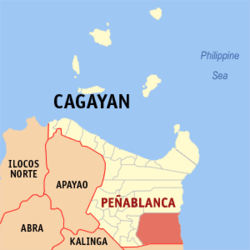Peñablanca (Cagayan)
| Municipality of Peñablanca | ||
| Location of Peñablanca in the province of Cagayan | ||
|---|---|---|

|
||
| Basic data | ||
| Region : | Cagayan Valley | |
| Province : | Cagayan | |
| Barangays : | 24 | |
| District: | 3. District of Cagayan | |
| PSGC : | 021519000 | |
| Income class : | 1st income bracket | |
| Households : | 6690 May 1, 2000 census
|
|
| Population : | 48,584 August 1, 2015 census
|
|
| Coordinates : | 17 ° 38 ′ N , 121 ° 47 ′ E | |
| Postal code : | 3502 | |
| Geographical location in the Philippines | ||
|
|
||
Peñablanca is a municipality in the Philippine province of Cagayan and is located in the southeast of the province on the Philippine Sea .
Most of the population lives from agriculture. Rice , corn , mung beans and peanuts are preferred .
history
Fossil human remains from the Callao Cave date to at least 67,000 years before today and give an indication of the long history of settlement in Peñablanca and the island of Luzon. The archaeological sites in Cagayan Valley and the rock paintings in the caves that lie within the municipality, working together with the Angono Petroglyphs since 2006 on the proposed list of the Philippines for inclusion on the World Heritage List of UNESCO .
During the Spanish colonial period, Peñablanca was a district of Tuguegarao and only became independent in 1896 .
location
Peñablanca is located in the Sierra Madre , which makes the region very mountainous. Sometimes the terrain rises to over 1500 meters. In the south, the municipality borders on the province of Isabela . In the north-west of the municipality is the Peñablanca Protected Landscape & Seascape nature reserve , which covers an area of 1187.81 km².
City structure
Peñablanca is divided into the following 24 barangays :
|
|
Individual evidence
- ^ ASB Mijares, F. Détroit, P. Piper, R. Grün, P. Bellwood, M. Aubert, G. Champion, N. Cuevas, A. De Leon, E. Dizon: New evidence for a 67,000-year-old human presence at Callao Cave, Luzon, Philippines. In: Journal of Human Evolution. 59. pp. 126-132.
